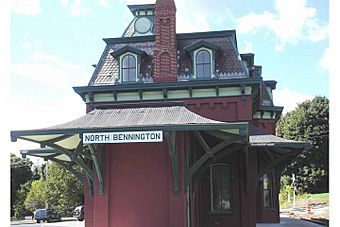North Bennington Depot facts for kids
|
North Bennington Depot
|
|
|
U.S. Historic district
Contributing property |
|
 |
|
| Location | Depot St. and Buckley Rd., North Bennington, Vermont |
|---|---|
| Area | 1 acre (0.40 ha) |
| Built | 1880 |
| Architectural style | Second Empire, Mansard |
| Part of | North Bennington Historic District (ID80000328) |
| NRHP reference No. | 73000189 |
Quick facts for kids Significant dates |
|
| Added to NRHP | April 11, 1973 |
| Designated CP | August 29, 1980 |
The North Bennington Depot is a historic train station in North Bennington, Vermont. You can find it where Depot Street and Buckley Road meet. This building was built in 1880. It was a busy place where people caught trains. This brick building shows how important North Bennington used to be. It was a major center for trains in southwestern Vermont. The depot was added to the National Register of Historic Places in 1973. This means it's a special building that is protected for its history.
About the North Bennington Depot
The North Bennington Depot is just north of the main village area. It sits next to the train tracks used by the Vermont Railway. There's also a smaller track nearby that goes into downtown Bennington.
What the Station Looks Like
The depot is a two-story building made of brick. It has a special roof called a mansard roof. This roof has a fancy edge with decorative supports. The roof is made of colorful slate tiles. The upper part of the roof has small windows with rounded tops. These windows are in little gabled sections.
Near the middle of the building, facing the street, there's a tower with a mansard roof too. The ground floor has wide coverings that stick out. These coverings are held up by large, carved wooden supports. Inside, the building has two separate waiting areas. An eight-sided ticket office sits between them, facing the tracks. There's also a small area for luggage attached to one end of the building.
A Bit of History
In the 1800s, North Bennington became a very important place for trains. It was a major railway junction. This means different train lines met here. Trains from the Rutland Railroad connected with lines going to New York and Massachusetts.
The Rutland Railroad built this station in 1880. They wanted to make train travel better for passengers. It replaced an older wooden station. However, fewer people rode trains in the 1930s. The railroad also started to have money problems. Because of this, the station was eventually left empty.
Luckily, the station was saved from being torn down in the 1970s. It was carefully fixed up and restored. For a while, it was even used for local government offices.



